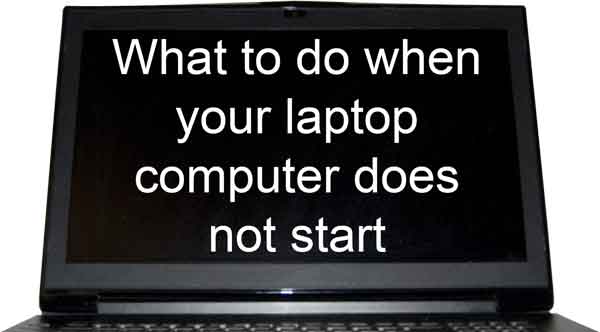Are you having a problem starting up your laptop? Is it not turning on when you press the power button? If so, here is what to do if your laptop does not start.

If you're reading this, chances are your laptop is not starting up. Don't worry; you're not alone. Laptop startup issues are common and can be caused by a variety of reasons. In this blog post, we'll discuss the steps you can take to troubleshoot and fix the issue.
Disconnect external devices
If your laptop is not starting up, it could be due to an external device connected to it has failed. Disconnect all external devices, including USB drives, external hard drives, and printers. Try booting up your laptop again and see if it works.
Check the AC jack
When you plug in the AC adapter, does it make a solid connection with the jack? Does it wiggle back and forth when it does plugin? If it does, you can try holding it to one side or the other and see if your laptop will power on. If your laptop powers up, then you will need to have the AC jack replaced.
Check the power source
A failed power adapter is the most common cause of a laptop not powering on. What usually happens is that the power adapter output will gradually diminish over time and eventually not have enough output to power the laptop and charge the battery.
When the output from the charger drops below a certain level, the laptop will turn to the battery for power. When the battery runs out of power, your laptop will not start. If you have a spare laptop charger, now is the time to try it.
If you keep your AC adapter plugged in all the time and it is over three years old, you may need to get a replacement. If it is the original charger that came with your laptop, there should be a model number on it that you can use to order a new one.
Note: The following procedures require the disassembly of your laptop computer. If you do not feel comfortable taking your laptop apart, don't hesitate to contact a local computer repair technician.
Check the battery
If you find the AC charger to be in good working order, then it is time to check the battery. On most laptops, you will need to partially disassemble it to gain access to the battery. Most of the time, it means you have to remove the base cover (bottom).
To find out the correct way to disassemble your system, you will need to find a service manual for it. A quick Google search for the make and model of your laptop plus 'service manual' should find you a manual. For example: Dell XPS 8950 service manual.
Once you have a service manual, grab your smartphone or digital camera to take photos as you go along. The manual will show you how to take your laptop apart, but it does not show the wire colors, actual screw locations, etc. Taking photos as you disassemble your system makes it much easier to reassemble.
Now that you have the base cover off, you will need to disconnect the battery. To determine if the battery is causing the problem, you should try starting the laptop with the battery disconnected using just the AC adapter.
First, we need to release any residual electrical charge that may be left in the system. With the battery disconnected, press and hold the power button down for 15 - 30 seconds. Once done, you can connect the AC adapter and attempt to start your laptop without the battery.
Starting your laptop without the base cover can be tricky, since you have the AC adapter plugged in and be able to press the power button. With the base cover off, swing up the base so it is 90 degrees from the display. Depending on the location of the power button and power jack, you will need to either place your laptop on the left side, right side, or the back of the display.
Once you have your laptop set up, go ahead and try powering it up. If it does start, let it start up and then carefully shut it down. Disconnect the AC adapter, reconnect the battery, reconnect the AC adapter, and try to start it up. If your laptop starts, it just needed a power reset to bring it back to life. Shut it down and reassemble it per the service manual.
If your laptop starts using just the AC adapter but not with the battery connected, you know the battery has failed and needs to be replaced. You can run your laptop without the battery connected temporarily, but you may need to set the date and time when you start the computer.
Reseat the components
If your laptop did not start using just the AC adapter, disconnect the AC adapter and press and hold the power button down for 15 - 30 seconds to discharge any of the residual power left in the laptop.
Following the service manual, proceed to reseat the components that are removable/reconnectable. (drives, memory modules, and wifi card). After reseating components, try powering your laptop up using just the AC adapter.
If your laptop still does not start up, check for any signs of power going through the motherboard. Are there any lights that turn on? Do any fan(s) move when you press the power button? If not, there is a good chance that the motherboard has failed.
In conclusion, laptop startup issues can be frustrating but can be resolved. Try these steps to troubleshoot and fix the problem. If, after following the steps outlined in this blog and your laptop still does not start, you may need to seek help from a computer repair technician.